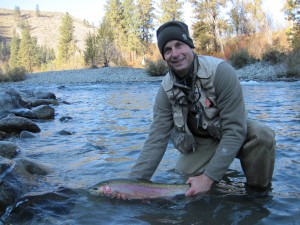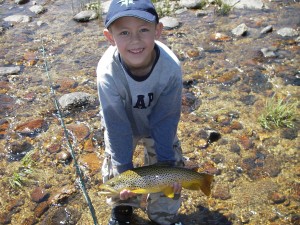Conservation Work That Lasts
by Scott Yates, director of TU’s Western Water Project
I’m a Washington native and used to ride bikes with my brother all summer to ply mesmerizing waters in the Methow River Valley with worms, (live) hoppers, and Pautzke’s “Balls O’ Fire” eggs.
I am unabashedly addicted to fishing for large rainbow and brown trout on the Henry’s Fork River.
There are special and quiet places to fish in Wyoming that I will take to my grave – but some of the most exhilarating fishing I’ve had in recent years included trying to outpace other boats while Jeff Streeter adeptly kept me in the feeding lane during the green drake hatch in Rainbow Canyon on the lower Encampment River.
On multiple 24 hour trips that generally started at four in the morning, I used to drive from Red Bluff, California, to meet Steve Trafton and fish from dawn till dusk on the Yuba River – one of the truly great late evening caddis rivers in the West.
Last summer, I fished with three tremendous anglers, good friends, and defenders of all things trout – Russ Schnitzer, Keith Curley, and Drew Peternell – and for the first time waded the rough and roily waters of the Colorado River as it leaves its verdant upper valley and descends through Gore Canyon.
My first time fishing in Montana was in 1999 with my Dad after an Idaho Council meeting on the Lochsa River--we drove over Lolo Pass, descended into the Bitterroot Valley, and then Bruce Farling floated us down the Blackfoot River in late-October; we finished in a white-out, giggling all the way to the boat ramp.
I learned to fly fish on the Deschutes River in the 1980s – memories of the “S” curves upstream of Maupin still help put me to sleep at night.
What do all these places have in common besides providing me a constant source of both memory and imagination? Over the past 15 years TU has made them all better fisheries. Perhaps most importantly, we’ve made a bunch of new friends along the way. Water transactions on the Methow and Blackfoot, passing streamflow legislation in Utah and developing innovative on-ranch conserved water projects, aggressively working with diverse stakeholders on large dam operations on the Henry’s Fork, Yuba, and Deschutes, mitigating transbasin diversions on the upper Colorado, and reconnecting and addressing legacy riparian and channel conditions on the Encampment – for a die-hard angler like myself, this is the kind of work that matters, because it’s the kind of work that lasts.
I’m looking forward to working on some great restoration projects in 2013 with my friends and colleagues in TU. Stay tuned – we’ll be writing more about our work in coming weeks and months in this space.



